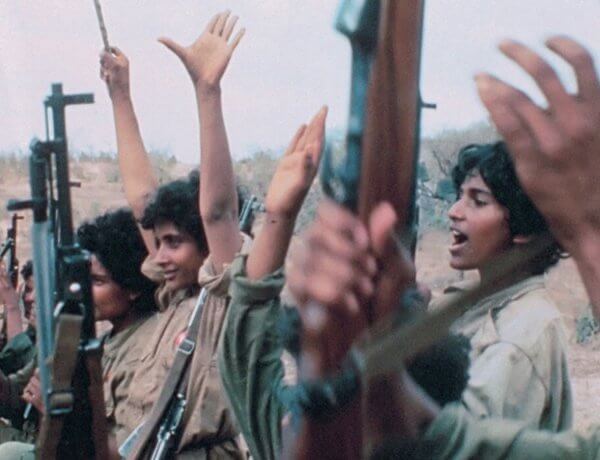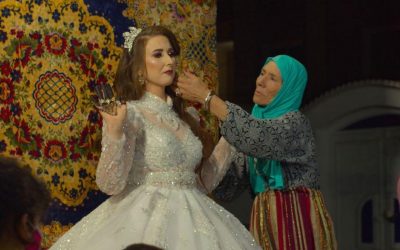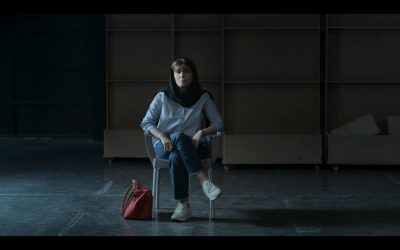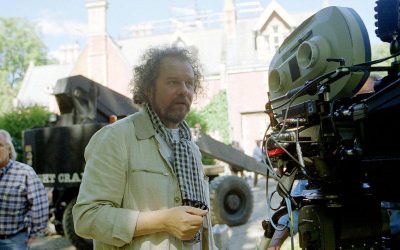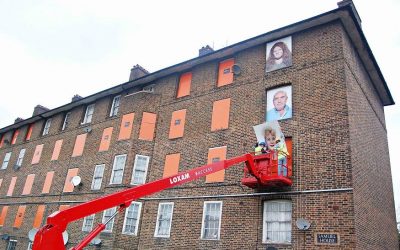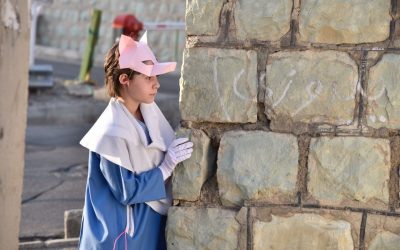Heiny Srour was born in Beirut, Lebanon in the mid-40’s. She studied anthropology at the Sorbonne under Maxime Rodinson, a renowned Orientalist and Social Anthropologist. It was during this time that she became interested in film, influenced by the ethnological films of French filmmaker Jean Rouch who also taught at the Sorbonne. While in this program she created her debut film – Saat El Tahrir Dakkat (The Hour of Liberation has Arrived), released in 1974. She had made one film prior to that, a short entitled Bread of Our Mountains (1968), whose footage was unfortunately lost during the Lebanese Civil War. The Hour of Liberation has Arrived is a documentary that chronicles the uprising in Dhofar by the Popular Front for the Liberation of Oman and the Arabian Gulf (PFLOAG) against the British-backed Sultanate of Oman. Srour chose to make this film after an interview with a member of PFLOAG for Africasia, an anti-colonial magazine where she was a film critic. Srour said in an interview how surprised she was when this male PFLOAG member brought up the subject of women in the organization and said that they were fighting against women’s oppression “because women were not just oppressed by imperialism and class society, but also by their father, husband, brothers.” Srour goes on to say that after hearing that, she dropped everything and put her full focus into the film. The struggle for liberation in Oman is considered one of the most radical in the Arab world. Women and children were an active part of it all, including on the front lines of fighting. Srour and her team crossed 500 miles of desert and mountains by foot, under bombardment by the British Royal Air Force, to reach the conflict zone and capture this. The People’s Liberation Army— barefoot, without rank or salary— freed a third of the territory, while undertaking a vast program of social reforms and infrastructure projects— schools, farms, hospitals, and roads were built, while illiterate teenage shepherdesses became feminists and 8-year-old school children learned to practice democracy. It is a portrait of liberated society and an exploration of the role of oil in U.S. and British involvement in the Middle East. Despite being banned in her home country as well as most of the Arab World, The Hour of Liberation Has Arrived was widely well-received and was selected to screen at the Cannes Film Festival, making it the first film by an Arab woman to do so and solidifying Srour’s place in filmmaking history. The film was restored in 2019 by Nadi Lekol Nas. Her next film was her first and only feature-length fiction film, entitled Leila wa al ziap (Leila and the Wolves), released in 1984. It tells the story of Leila, a young Lebanese woman residing in London who time-travels throughout twentieth-century Lebanon and Palestine. The film is an exploration of the collective historical memory of Arab women told through dramatizations of situations faced by women in these countries. Women are a central theme in Srour’s work. In an interview with Mary Jiramanus Saba about The Hour of Liberation Has Arrived, Srour speaks of her motivation for making that film, which clearly extended into her other work. She said ” My aspirations for the film were artistic and feminist. In terms of style, my favorite filmmaker was Fellini. And when I saw 8 ½, I realized that cinema was a very powerful medium that could express everything I wanted to say. But my main motivation in overcoming so many hurdles was feminist.” She is extremely vocal about her position of women in Arab society and in 1978 she, along with other Arab women in film, set up a new assistance fund “for the self-expression of women in cinema”.
Heiny Srour continued her work as a filmmaker into the early 2000’s, releasing a number of shorts and documentaries, many of which reflect the same themes seen in these two features, but on a global scale. They include: The Singing Sheikh (1991), Women of Vietnam (1992), The Eyes of the Heart (1994), and Woman Global Strike (2000). She has also written several screenplays, co-produced her films and she taught at the London International Film School and Goldsmith College in the 1980’s.
The Hour of Liberation
GUY HENNEBELLE, MONIQUE MARTINEAU HENNEBELLE, 1974
TRANSLATED BY SIS MATTHÉ
Lebanese filmmaker Heiny Srour shot a one-hour film in the liberated zone of the Sultanate of Oman. The film is called The Hour of Liberation, and it was selected at The International Critics’ Week of this year’s Cannes Film Festival. With regard to Arab cinema, which – despite the current revival – is often still trying to find its way politically, this film has the merit of being based on an unusually clear ideological analysis. Compared to French (and European) cinema, it has the advantage of proposing a particularly effective method and approach on which it would be appropriate to reflect in order to develop militant cinema, for example, which, as we know, is still barely able to avoid a rather boring didacticism. The filmmaker talks about the reasons that led her to make this film and about her political and aesthetic ideas.
Guy Hennebelle and Monique Martineau Hennebelle: Heiny Srour, why this film?
Heiny Srour: For several reasons. First of all, to break the conspiracy of silence reigning over the struggle the Popular Front for the Liberation of Oman (PFLO) has been waging for the past nine years in a region containing two thirds of the world’s oil reserves and currently supplying a quarter of the world’s production, thus providing fabulous superprofits to imperialism.
Secondly, to underline the exemplary role of a Vietnamese-style Arab liberation struggle. Finally, because as a feminist, I was particularly enthusiastic about the way in which the PFLO views and resolves the issue of women’s emancipation. This is, indeed, the first time in the Arab world that an organized political force has considered women’s liberation as an end in itself and not just as a means to get rid of imperialism more quickly. It is the first time in the Arab world that what is preached is actually practiced. I felt it was important to pass on the experience of the PFLO, exemplary in many respects.
In which context is this struggle unfolding?
Since 1965, the Front has been fighting the feudalism of Sultan Said Bin Taimur who, allied with the British empire, kept the Sultanate of Oman (2,000,000 inhabitants, east of the Democratic Republic of Yemen and south of Saudi Arabia) in a situation I would describe as “medieval” in the cities and “nearly pre-historical” in the countryside. In his desire to stop time, the sultan did not want his subjects to import modern-world products: bicycles, medicines, radios… In 1970, the English replaced him with his son Qaboos, who introduced some tiny reforms but maintained slavery, for example. Committed to ending a revolution that risked spreading like wildfire across the Arabian Gulf, the British – as Oman is de facto a British protectorate – called on the Americans. The Americans in turn asked their allies in the region to intervene: Faisal of Saudi Arabia is giving money, Hussein of Jordan is sending his police, and the Shah of Iran has sent 3,000 men as reinforcements to the liberated zone and estimates the number of Iranians in Oman at 11,000. The liberated area (most of the western province of Dhofar, with a population of 200,000) is undergoing a genuine attempt at genocide. We must draw attention to a situation the international press is trying to hide. Hence this film. I spent three months in Dhofar, where I walked about 400 kilometres1 , together with a technical crew consisting of the cameraman Michel Humeau, the sound engineer Jean-Louis Ughetto and a Yemeni assistant, Itzhak Ibrahim Souleily.
The form of your film is extremely interesting: you have managed to combine a rigorous political account with a “sense of humanity”. While many French militant films are often dull and unappealing, your film fascinates from start to finish. You seem to have really worked on the montage.

Heiny Srour, Filmmaker
The film begins with a sequence of fixed colour shots, which is a sort of summary of the situation in the liberated zone, commented on by a liberation song hummed by a People’s Army fighter. This sequence is meant to get the spectator to identify with the revolution and, at the same time, establish that in the beginning was the people. The course of the film can be divided into two parts: the first, shorter part talks about the crimes of imperialism and its local allies; the second, longer part is devoted to a report from the liberated area. The imperialism in the Gulf is analyzed through television documents. The side of imperialism is in black and white. The side of the revolution is in colour, or red-tinged. When the documents from the imperialist side happened to be in colour, I had them duplicated in black and white… It seemed dangerous to me to turn the Royal Air Force planes into a beautiful spectacle. Generally speaking, I think it’s dangerous, politically, not to distinguish between the forces of oppression and the forces of liberation in terms of image and sound. Regarding the sound in this film, it is the voice of the combatant already mentioned which comments on the images captured on the other side of the fence, and it is the same voice which is calling for unity in the struggle. So, it is clear that we only used images from the side of imperialism because the Arab people were unable to record their history on film.
The Hour of Liberation is, therefore, a partisan film at all levels. In terms of the montage as well: you can’t place images filmed on both sides of the fence in any order, and tell the viewer to choose sides; that would put oppression and freedom, injustice and justice on the same level. The film is constructed on a structure that rejects the bourgeois conception of “objectivity”: it clearly takes sides, without necessarily hiding the difficulties of the struggle, without hiding the contradictions, without ultimately lapsing into triumphalism. The entire montage is conceived to produce an analysis of what a people’s war is. We first show, through the interview with a combatant, that the beginnings of a war of this type are very difficult because there are generally few means of action and you must essentially rely on your own strengths. Then we analyze the reasons behind the strength of the revolution: mobilization of the masses, unity among the people, women’s liberation. The film sets out to illustrate the principle that in a people’s war, the army is at the service of the people. So you notice the political role of the Liberation Army. And its productive role as well. Towards the end of the film, the conference in which a leader explains that “ideology guides the gun” sums up the reasons for the Front’s success.
In the film, captions guide the viewer towards a political reading: it is indeed important to contribute to a deconditioning of the Arab spectator who had absorbed film images as a drug for fifty years. The captions make it possible to break the “spectacle” by encouraging the spectators to keep their critical sense alive, to bring them to consider a sequence as a political lesson, not just as a series of images. But I didn’t add too many of these captions, as their accumulation would have become boring. You must avoid both losing the spectators by boring them and stupefying them by entertaining them. In terms of the editing, I tried very hard to avoid both excesses. On the other hand, I tried to make maximum use of the popular culture from the region, for example by inserting songs sung by the partisans into the film; apart from being politically sophisticated, they are also very beautiful artistically. And finally, whenever possible, I used the original dialogue instead of a commentary.
By and large, I tried to integrate the Arab oral tradition into the sound of the film, a fundamental element of the people’s culture in our country. In a militant film, it’s crucial to refer to the people’s culture if you really want to reach the audience the film is made for. As for the image, the captions introduced the tradition of the arabesque.
What is your view on the direction that Arab cinema should take?
To answer this question, we must first define the historical period we are going through and the political tasks falling to every Arab person, whether or not a filmmaker. Today, the Arab world is going through a period of democratic national revolution. Our main enemy is imperialism and its local allies: the comprador bourgeoisie and feudalism. The basis of this Arab revolution consists of the poor masses, both the working class and the peasants. The avant-garde is, of course, the working class. Right now, its allies are the petty bourgeoisie and the national bourgeoisie. If we want to identify the main element, if we want to hit the target with our camera gun, we must focus our efforts against the main enemy and give voice to the main basis of the revolution: the poor masses. The allies of the revolution (petty bourgeoisie and national bourgeoisie) do not deserve to be more than just allies. All the more so because the wealthy have been the objects and subjects of art in all its expressions for thousands of years. This has been the case in cinema since it was invented. Consequently, content-wise, the enemy of the people is any cinema made by the neutral for the use of the rich and the less rich who want to keep their hands clean, their eyes closed and their ears deaf.
Our enemy is any cinema that does not speak of national and social oppression in all its forms, including female oppression, and does not denounce it.
Our enemy is a cinema that does not speak of the plundering of our national resources, of poverty and suffering.
Our enemy is any cinema that turns its back on historical emergencies, taking refuge in a mythical past through a contemplative approach that is nothing but a flight from the present.
Our enemy is any cinema that deals with so-called universal problems without giving them a social and national dimension. For example, one cannot speak of love “innocently”: it is not the same in a society where women are equal to men or in a society where she is his slave, his beast of luxury or his beast of burden.
So much for the content. As for the form, our enemy is any esoteric cinema reserved for elites and the idle.
Our enemy is any vulgar cinema, any simplistic and triumphalist cinema, because it lapses into demagogy.
Our enemy is any cinema that suffers the moral terrorism of the perfect and finished work of art. Any cinema that does not seek new forms to express new content. Any cinema settled in the intellectual comfort of the aesthetic canon established by and for the wealthy. Any cinema that uses the iconography, symbolism and moral values of the other side.
For we cannot treat our responsibilities as filmmakers with disdain and ignore the tremendous impact of images and sounds. The imperialists, for their part, do not undervalue this. They are currently putting our entire civilization in mortal danger. We must arm ourselves with intolerance against the enemies of freedom.
Our principle is: whoever is not with us is against us. Our practice: ideology must guide the camera.
The source of the article:
https://arabfilminstitute.org/
https://www.sabzian.be/text/
https://www.rustedradishes.

